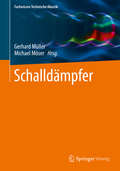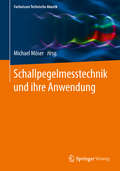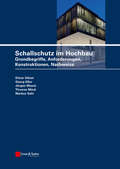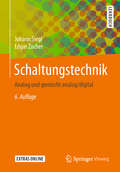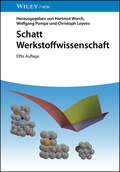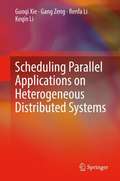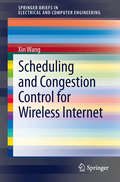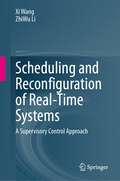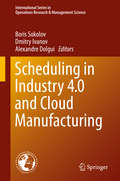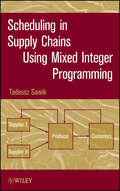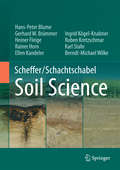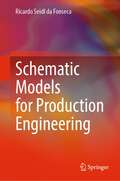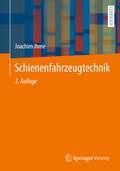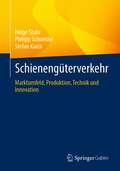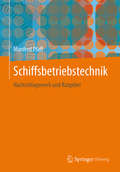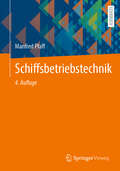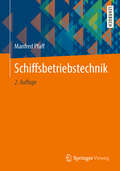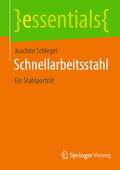- Table View
- List View
Schalldämpfer (Fachwissen Technische Akustik)
by Michael Möser Gerhard MüllerDieser Band der Reihe Fachwissen Technische Akustik behandelt die Anwendungsbereiche, Bauformen und Wirkprinzipien von Industrieschalldämpfern. Im Mittelpunkt stehen Absorptionsschalldämpfer, Resonatorschalldämpfer (Typ λ/4, Helmholtz), Drosselschalldämpfer und Ausblaseschalldämpfer. Berechnungsverfahren zur Dämpfung, zum Strömungsrauschen und zu den Druckverlusten werden angegeben. Dabei werden insbesondere Absorptionsschalldämpfer vom Typ Kulissenschalldämpfer und Rohrschalldämpfer ohne und mit Kern betrachtet. Berechnete Dämpfungsspektren werden Mess- und Erfahrungswerten gegenübergestellt. Abschließend werden genormte Labor- und Feldmessverfahren an Schalldämpfern erläutert, wobei Messungen im Einsatzfall großer Industrieschalldämpfer besondere Beachtung finden.
Schallpegelmesstechnik und ihre Anwendung (Fachwissen Technische Akustik)
by Michael MöserDieser Band der Reihe Fachwissen Technische Akustik enthält neben den allgemeinen Definitionen der Mess-, Bewertungs- und Beurteilungsgrößen und der Beschreibung der Funktion und des Aufbaus von Schallpegelmessern eine umfangreiche Darstellung der Verfahren zur Erfassung und Beurteilung von Geräuschemissionen und -immissionen auf der Basis aktueller Regelwerke. Bezüglich der Emission geschieht dies für Geräte, Maschinen, Fahrzeuge und Anlagen, auf der Immissionsseite wird der Arbeitsplatz sowie der Umgang mit Gewerbe-, Industrie-, Bau- und Verkehrslärm betrachtet. Der Beitrag schließt mit einer umfangreichen Literaturzusammenstellung hinsichtlich der entsprechenden Regelwerke.
Schallschutz im Hochbau: Grundbegriffe, Anforderungen, Konstruktionen, Nachweise
by Elmar Sälzer Georg Eßer Jürgen Maack Thomas Möck Markus SahlNeben der Erläuterung der Grundbegriffe werden die schalltechnischen Anforderungen aus bauaufsichtlicher und zivilrechtlicher Sicht dargestellt und verglichen. Die benötigten Konstruktionen sowohl für den Massivbau als auch aus dem Bereich der elementierten Bauteile werden mit ihren schalltechnischen Eigenschaften und Besonderheiten dargestellt. Hierbei konnten die Autoren auf die Messergebnisse von mehreren Tausend Messungen, und zwar sowohl im schalltechnischen Labor als auch von Güteprüfungen des Schallschutzes am Bau, zurückgreifen. Dem Anwender ist es somit möglich, verschiedene Alternativen mit unterschiedlichen Standards unter Berücksichtigung der Wirtschaftlichkeit vergleichend gegenüber zu stellen. Die mit den ausgewählten Konstruktionen zu führenden Nachweise zur Erfüllung der bauaufsichtlichen Anforderungen und zum Nachweis zivilrechtlicher Anforderungen werden beschrieben. Die Autoren vereinen ihre jahrzehntelangen Erfahrungen aus Planungspraxis, Gutachtertätigkeit, Produktprüfung und Messungen am Bau zu einem einzigartigen Handbuch, das für den baulichen Schallschutz ein Zeichen setzt.
Schallwirkungen beim Menschen (Fachwissen Technische Akustik)
by Michael Möser Gerhard MüllerDieser Band der Reihe Fachwissen Technische Akustik behandelt die physiologischen Aspekte des Hörsystems sowie die akustische Wahrnehmung des Menschen. Die Autoren untersuchen die durch Lärm verursachten gesundheitlichen Beeinträchtigungen. Abschließend werden nichtakustische Einflussgrößen (Moderatoren) erläutert.
Schaltungstechnik: Entwicklungsmethodik, Funktionsschaltungen, Funktionsprimitive Von Schaltkreisen (Springer-Lehrbuch)
by Johann Siegl Edgar ZocherDas Lehrbuch bietet eine gründliche und systematische Einführung in die Entwicklungs- und Analysemethodik analoger und gemischt analog/digitaler Schaltungen. Leser lernen, wie Schaltungen erfolgreich entwickelt werden können. Wesentlich hierfür ist die funktionsorientierte Vorgehensweise, die durch eine Einführung in die Abschätzanalyse und in rechnergestützte Entwurfsverfahren unterstützt wird. Mit vielen anschaulichen Beispielen und Übungsaufgaben. Zusätzlich kann ein virtuelles Labor mit 300 Experimenten und weiteren Aufgaben genutzt werden.
Schatt Werkstoffwissenschaft
by Georg SchwedtDer Klassiker der Werkstoffwissenschaft in elfter Auflage – unverzichtbar für Studierende der Werkstoffwissenschaft/Materialwissenschaft und des Maschinenbaues Die moderne Werkstoffwissenschaft befasst sich mit der Darstellung und Erklärung der Eigenschaften von Werkstoffen wie Metallen, Keramiken und Polymeren auf Grundlage einer einheitlichen, naturwissenschaftlich geleiteten Betrachtungsweise. Damit geht dieses Wissensgebiet über die klassische Werkstoffkunde hinaus, die auf vorwiegend empirisch ermittelten Fakten ohne engen Verständniszusammenhang basiert. Die stark interdisziplinär geprägte Werkstoffwissenschaft bedient sich dabei der Erkenntnisse und Methoden der Festkörperphysik und -chemie, der Kristallographie und des Ingenieurwesens und ist als Kernfach in material- und ingenieurwissenschaftlichen Studiengängen an Universitäten und Hochschulen verankert. Ausgehend von den idealen und realen Strukturen von Metallen, Keramiken und Polymeren liefert dieses Standardlehrbuch eine Einführung in die grundlegenden Herstelltechniken von Werkstoffen, Phasenbildung und -umwandlung und die für praktische Anwendungen so wichtigen Zustandsdiagramme sowie die Entstehung und der Untersuchung des Gefüges von Werkstoffen mit qualitativen und quantitativen Charakterisierungsmethoden. Die folgenden Kapitel widmen sich der Beschreibung und Erklärung von thermisch aktivierten Vorgängen wie Diffusion, der Korrosion, den mechanischen Eigenschaften wie Plastizität und Bruch sowie den physikalischen Eigenschaften wie elektrische und thermische Leitfähigkeit, Supraleitung und der Wechselwirkung von Strahlung und Festkörpern. Die 11. Auflage ergänzt die mechanischen Erscheinungen durch Ausführungen, mit deren Hilfe eine konsistente Einordnung der werkstoffwissenschaftlichen Betrachtungen in den Kontext der Technischen Mechanik möglich wird, und behandelt neu ausführlich die Werkstoffe Biopolymere im Speziellen und Biomaterialien im Allgemeinen. Die Herstelltechniken wurden ergänzt durch neue Abschnitte zur modernen additiven Fertigung.
Scheduling Parallel Applications on Heterogeneous Distributed Systems
by Gang Zeng Guoqi Xie Renfa Li Keqin LiThis book focuses on scheduling algorithms for parallel applications on heterogeneous distributed systems, and addresses key scheduling requirements – high performance, low energy consumption, real time, and high reliability – from the perspectives of both theory and engineering practice. Further, it examines two typical application cases in automotive cyber-physical systems and cloud systems in detail, and discusses scheduling challenges in connection with resource costs, reliability and low energy. The book offers a comprehensive and systematic treatment of high-performance, low energy consumption, and high reliability issues on heterogeneous distributed systems, making it a particularly valuable resource for researchers, engineers and graduate students in the fields of computer science and engineering, information science and engineering, and automotive engineering, etc. The wealth of motivational examples with figures and tables make it easy to understand.
Scheduling and Congestion Control for Wireless Internet
by Xin WangThis brief proposes that the keys to internet cross-layer optimization are the development of non-standard implicit primal-dual solvers for underlying optimization problems, and design of jointly optimal network protocols as decomposition of such solvers. Relying on this novel design-space oriented approach, the author develops joint TCP congestion control and wireless-link scheduling schemes for wireless applications over Internet with centralized and distributed (multi-hop) wireless links. Different from the existing solutions, the proposed schemes can be asynchronously implemented without message passing among network nodes; thus they are readily deployed with current infrastructure. Moreover, global convergence/stability of the proposed schemes to optimal equilibrium is established using the Lyapunov method in the network fluid model. Simulation results are provided to evaluate the proposed schemes in practical networks.
Scheduling and Reconfiguration of Real-Time Systems: A Supervisory Control Approach
by Xi Wang ZhiWu LiThis book presents a methodology for the real-time scheduling problems of real-time systems (RTS) from the viewpoint of control theory. Generally, any system can be viewed as an RTS if it performs real-time application functions and behaves correctly depending on given logical activities and satisfying specified deadlines for the activities. This monograph provides broad views and detailed introductions to supervisory control theory (SCT) and its application in real-time scheduling and reconfiguration. Based on three popular SCT modelling frameworks, discrete-event system (DES), timed DES (TDES), and state-tree structures (STS), the authors provide RTS modelling frameworks; thereafter, SCT is used to find their safe execution sequences. As the main contribution, we use (untimed) DES events to represent the execution and preemption of each individual RTS task. This modelling formalism brings the possibilities to model the preemptions of tasks’ executions. Furthermore, in some cases, priorities cannot be assigned to real-time tasks. In order to solve this problem, a matrix-based priority-free conditional-preemption (PFCP) relation is provided, which generalizes fixed-priority (FP) RTS scheduling. As a natural extension, a generalized modular modelling framework is presented to model the task parameters instead of the global real-time task. The modular models are taken to be generic entities, which also considers the exact execution time of real-time tasks. STS are undoubtedly recognized as a computationally efficient SCT framework which manages the state explosion problem significantly. Hence, building on the (untimed) modular RTS models, a novel STS-based RTS modeling framework is formulated, by assigning dynamic priorities as specified optimality criteria, which can be utilized to model sporadic RTS processing both sporadic and (multi-period) periodic tasks, providing a small set of the safe execution sequences which rank at the top.
Scheduling in Industry 4.0 and Cloud Manufacturing (International Series in Operations Research & Management Science #289)
by Dmitry Ivanov Alexandre Dolgui Boris SokolovThis book has resulted from the activities of IFAC TC 5.2 “Manufacturing Modelling for Management and Control”. The book offers an introduction and advanced techniques of scheduling applications to cloud manufacturing and Industry 4.0 systems for larger audience. This book uncovers fundamental principles and recent developments in the theory and application of scheduling methodology to cloud manufacturing and Industry 4.0.The purpose of this book is to present recent developments in scheduling in cloud manufacturing and Industry 4.0 and to systemize these developments in new taxonomies and methodological principles to shape this new research domain. This book addresses the needs of both researchers and practitioners to uncover the challenges and opportunities of scheduling techniques’ applications to cloud manufacturing and Industry 4.0. For the first time, it comprehensively conceptualizes scheduling in cloud manufacturing and Industry 4.0 systems as a new research domain. The chapters of the book are written by the leading international experts and utilize methods of operations research, industrial engineering and computer science. Such a multi-disciplinary combination is unique and comprehensively deciphers major problem taxonomies, methodologies, and applications to scheduling in cloud manufacturing and Industry 4.0.
Scheduling in Supply Chains Using Mixed Integer Programming
by Tadeusz SawikA unified, systematic approach to applying mixed integer programming solutions to integrated scheduling in customer-driven supply chains Supply chain management is a rapidly developing field, and the recent improvements in modeling, preprocessing, solution algorithms, and mixed integer programming (MIP) software have made it possible to solve large-scale MIP models of scheduling problems, especially integrated scheduling in supply chains. Featuring a unified and systematic presentation, Scheduling in Supply Chains Using Mixed Integer Programming provides state-of-the-art MIP modeling and solutions approaches, equipping readers with the knowledge and tools to model and solve real-world supply chain scheduling problems in make-to-order manufacturing. Drawing upon the author's own research, the book explores MIP approaches and examples-which are modeled on actual supply chain scheduling problems in high-tech industries-in three comprehensive sections: Short-Term Scheduling in Supply Chains presents various MIP models and provides heuristic algorithms for scheduling flexible flow shops and surface mount technology lines, balancing and scheduling of Flexible Assembly Lines, and loading and scheduling of Flexible Assembly Systems Medium-Term Scheduling in Supply Chains outlines MIP models and MIP-based heuristic algorithms for supplier selection and order allocation, customer order acceptance and due date setting, material supply scheduling, and medium-term scheduling and rescheduling of customer orders in a make-to-order discrete manufacturing environment Coordinated Scheduling in Supply Chains explores coordinated scheduling of manufacturing and supply of parts as well as the assembly of products in supply chains with a single producer and single or multiple suppliers; MIP models for a single- or multiple-objective decision making are also provided Two main decision-making approaches are discussed and compared throughout. The integrated (simultaneous) approach, in which all required decisions are made simultaneously using complex, monolithic MIP models; and the hierarchical (sequential) approach, in which the required decisions are made successively using hierarchies of simpler and smaller-sized MIP models. Throughout the book, the author provides insight on the presented modeling tools using AMPL® modeling language and CPLEX solver. Scheduling in Supply Chains Using Mixed Integer Programming is a comprehensive resource for practitioners and researchers working in supply chain planning, scheduling, and management. The book is also appropriate for graduate- and PhD-level courses on supply chains for students majoring in management science, industrial engineering, operations research, applied mathematics, and computer science.
Scheffer/SchachtschabelSoil Science
by Karl Stahr Hans-Peter Blume Gerhard W. Brümmer Heiner Fleige Rainer Horn Ellen Kandeler Ingrid Kögel-Knabner Ruben Kretzschmar B. Michael WilkeThe soils are fundamental to our existence, delivering water and nutrients to plants, that feed us. But they are in many ways in danger and their conservation is therefore a most important focus for science, governments and society as a whole. A team of world recognised researchers have prepared this first English edition based on the 16th European edition. * The precursors and the processes of soil development * The physical, biological and chemical properties of soils * Nutrients and Pollutants * The various soil classifications with the main focus on the World Reference Base for Soil Resources (WRB) * The most important soils and soil landscapes of the world * Soil Evaluation Techniques * Basic Principles of Soil Conservation Whoever works with soils needs this book.
Schematic Models for Production Engineering
by Ricardo Seidl da FonsecaThe book is a comprehensive guide to schematic models of methods engineering, offering a detailed analysis of these models and their applications in a variety of engineering fields. By bringing together the most significant schematic models in a single text and analyzing them according to a common structure, the book enables readers to visualize possible interventions and improvements in work situations. Focused on the conceptualization and analysis of schematic models, the text covers an area of knowledge that is central to production and industrial engineering, but also widely used in other engineering disciplines. The book presents an updated version of a representative set of schematic models, making it an invaluable resource for engineers in the field. With the growing automation of production and the introduction of robotics and the "internet of machines", the use of schematic models is more important than ever in achieving quality and safety in production projects, whether in manufacturing, industrial processes, or services. The book demonstrates how schematic models of methods are essential tools for the study and analysis of current business or production processes, as well as for the implementation of new systems and their maintenance. Overall, this book is a must-read for engineers seeking to improve their knowledge and practical application of schematic models, providing valuable insights and guidance for professionals in a range of engineering fields.
Schienenfahrzeugtechnik
by Joachim IhmeDieses Lehrbuch behandelt die theoretischen Grundlagen und die Technik von Eisenbahn- und Straßenbahnfahrzeugen. Neben den gesetzlichen Grundlagen werden Fahrwiderstände, Antriebe, Bremsen, Laufdynamik und Laufwerke sowie die Tragwerke und Aufbauten behandelt. Großer Wert wird dabei auf anschauliche Darstellungen und zahlreiche Beispiele gelegt. Anhand dieses Buches können sich auch fachfremde Ingenieure und Eisenbahnfreunde in das Gebiet der Schienenfahrzeugtechnik erfolgreich einarbeiten. Die vorliegende Auflage wurde überarbeitet und um das Kapitel "Engineering im Schienenfahrzeugbau" ergänzt.
Schienenfahrzeugtechnik
by Joachim IhmeDieses Lehrbuch behandelt die theoretischen Grundlagen und die Technik von Eisen- und Straßenbahnfahrzeugen. Neben den gesetzlichen Grundlagen werden Fahrwiderstände, Antriebe, Bremsen, Laufdynamik und Laufwerke sowie die Tragwerke und Aufbauten behandelt. Großer Wert wird dabei auf anschauliche Darstellungen und zahlreiche Beispiele gelegt. Anhand dieses Buches können sich auch fachfremde Ingenieure und Eisenbahnfreunde in das Gebiet der Schienenfahrzeugtechnik erfolgreich einarbeiten. Die vorliegende Auflage wurde überarbeitet, um weitere Beispiele ergänzt und im Abschnitt "Hybridfahrzeuge" erweitert.
Schienengüterverkehr: Marktumfeld, Produktion, Technik und Innovation
by Helge Stuhr Philipp Schneider Stefan KarchDer Schienengüterverkehr ist im Hinblick auf den Klimaschutz zu einem Hoffnungsträger für mehr Nachhaltigkeit im Verkehrssektor geworden. Für die Transportverlagerung von Gütern auf die Schiene ist es notwendig, die Einsatzmöglichkeiten dieses Verkehrsträgers zu erweitern. Dabei stellen die Schaffung förderlicher Rahmenbedingungen, die Digitalisierung sowie der Einsatz weiterer Innovationen wesentliche Hebel dar, um die notwendigen Prozesse der Transportdurchführung so effektiv und verlässlich wie möglich zu gestalten.Das Buch beschreibt die Grundlagen des Verkehrsträgers Schiene. Es zeigt, was der Schienengüterverkehr leisten kann, wo seine Schwächen liegen, welche Grundlagen der Bahntechnik aus der Perspektive des SGV zu beachten und welche Ressourcen notwendig sind. Zahlreiche Beispiele bieten einen Einblick in den Wandel der nationalstaatlich geprägten Bahnsysteme hin zum führenden, länderübergreifenden Transportsystem für Green Logistics.
Schiff Base Metal Complexes: Synthesis and Applications
by Pranjit Barman Anmol SinghSchiff Base Metal Complexes Schiff bases are compounds created from a condensed amino compounds, which frequently form complexes with metal ions. They have diverse applications in biology, catalysis, material science and industry. Understanding these compounds, their properties, and the available methods for synthesizing them is a key to unlocking industrial innovation. Schiff Base Metal Complexes provides a comprehensive overview of these compounds. It introduces the compounds and their properties before discussing their various synthesizing methods. A survey of existing and potential applications gives a complete picture and makes this a crucial guide for researchers and industry professionals looking to work with Schiff base complexes. Schiff Base Metal Complexes readers will also find: A systematic and organized structure designed to make information instantly accessible Detailed coverage of thermal synthesis, photochemical synthesis, and more Challenges with different methods described in order to help readers make the correct choice for their own work Schiff Base Metal Complexes is a useful reference for organic chemists, materials scientists, and researchers or industry professionals working with organometallics.
Schiffsbetriebstechnik
by Manfred PfaffDieses Fachbuch stellt in prägnanter und konzentrierter Form alle wesentlichen Aspekte dar, die zum Betrieb eines Schiffes gehören. Dazu gehören Grundlagen der Schwimmfähigkeit und Antriebstechnik, Schiffssicherheit, Arbeitssicherheit und Umweltschutz an Bord sowie wichtige Hilfseinrichtungen. Anhand zahlreicher Beispiele werden diese Aspekte genauer erklärt. Das Buch wendet sich an Schiffstechniker im Studium, an Bord und in Reedereien als auch an Konstrukteure in der Werft.
Schiffsbetriebstechnik
by Manfred PfaffDieses Lehrbuch stellt in prägnanter und verständlicher Form alle wesentlichen Aspekte dar, die zum Betrieb eines Schiffes gehören. Dazu gehören Grundlagen der Schwimmfähigkeit und Antriebstechnik, Schiffssicherheit, Arbeitssicherheit und Umweltschutz an Bord sowie wichtige Hilfseinrichtungen. Anhand zahlreicher Beispiele werden diese Aspekte genauer erklärt. Das Buch wendet sich an Schiffstechniker*innen im Studium, an Bord und in Reedereien als auch an Konstruierende in der Werft. Die aktuelle Auflage wurde u. a. in Bezug auf die "Rechtlichen Grundlagen" überarbeitet und aktualisiert sowie um das Kapitel "Werkstoffkunde und Werkstoffprüfung" ergänzt.
Schiffsbetriebstechnik
by Manfred PfaffDieses Lehrbuch stellt in prägnanter und verständlicher Form alle wesentlichen Aspekte dar, die zum Betrieb eines Schiffes gehören. Dazu gehören Grundlagen der Schwimmfähigkeit und Antriebstechnik, Schiffssicherheit, Arbeitssicherheit und Umweltschutz an Bord sowie wichtige Hilfseinrichtungen. Anhand zahlreicher Beispiele werden diese Aspekte genauer erklärt. Das Buch wendet sich an Schiffsmechaniker*innen in Ausbildung und Beruf wie auch an Schiffstechniker*innen im Studium, an Bord und in Reedereien als sowie an Konstruierende in der Werft. Die vorliegende Auflage wurde überarbeitet und aktualisiert und um aktuelle Themen ergänzt, wie den Flettner-Rotor und Entwicklungen zum Schiffswiderstand.
Schiffsbetriebstechnik: Nachschlagewerk Und Ratgeber
by Manfred PfaffDieses Lehrbuch stellt in prägnanter und verständlicher Form alle wesentlichen Aspekte dar, die zum Betrieb eines Schiffes gehören. Dazu gehören Grundlagen der Schwimmfähigkeit und Antriebstechnik, Schiffssicherheit, Arbeitssicherheit und Umweltschutz an Bord sowie wichtige Hilfseinrichtungen. Anhand zahlreicher Beispiele werden diese Aspekte genauer erklärt. Das Buch wendet sich an Schiffstechniker im Studium, an Bord und in Reedereien als auch an Konstrukteure in der Werft. Die aktuelle Auflage enthält u. a. eine Aktualisierung und Einarbeitung zu rechtlichen Rahmenbedingungen und zum Thema Arbeitssicherheit/Arbeitsschutz und wurde um das Kapitel „Physikalische Grundlagen“ deutlich erweitert.
Schistosoma mansoni: Methods and Protocols (Methods in Molecular Biology #2151)
by David J. TimsonThis volume details protocols for studying Schistosoma mansoni. Chapters guide readers through reviews on current drugs and drug discovery, methods to interrogate the cell biology of the worm, protocols to look at proteome level changes, prepare and work with specific proteins from S. mansoni, describes a drug screening, and how to test potential vaccine targets. Written in the highly successful Methods in Molecular Biology series format, chapters include introductions to their respective topics, lists of the necessary materials and reagents, step-by-step, readily reproducible laboratory protocols, and tips on troubleshooting and avoiding known pitfalls. Authoritative and cutting-edge, Schistosoma mansoni: Methods and Protocols aims to ensure successful results in the further study of this vital field.
Schlieren and Shadowgraph Methods in Heat and Mass Transfer
by Krishnamurthy Muralidhar Pradipta Kumar PanigrahiSchlieren and Shadowgraph Methods in Heat and Mass Transfer lays out the fundamentals of refractive index based imaging techniques, optical configurations, image analysis, and three dimensional reconstructions. The present monograph aims at temperature and concentration measurements in transparent media using ray bending effects in a variable refractive index field. Data analysis procedure for three-dimensional reconstruction of temperature and concentration field using images at different view angles is presented. Test cases illustrating the validation of the quantitative analysis procedure are presented.
Schnellarbeitsstahl: Ein Stahlporträt (essentials)
by Joachim SchlegelDie Welt des Stahls ist erstaunlich vielfältig und so komplex, dass sie in der Praxis nicht leicht zu überblicken ist. In Form von essentials zu Porträts von ausgewählten Stählen und Stahlgruppen soll dem Leser diese Welt des Stahls nähergebracht werden; kompakt, verständlich, informativ, strukturiert mit Beispielen aus der Praxis und geeignet zum Nachschlagen. Stähle für Werkzeuge, mit denen wiederum auch Stähle und andere Werkstoffe umgeformt und spanend bearbeitet werden, müssen schon sehr hart und verschleißfest sein. Ein Beispiel hierfür sind die Schnellarbeitsstähle. Wissenswertes über diese Stähle fasst dieses essential zusammen.
Schnelleinführung Elektronik: Zusammenfassung zur Vorbereitung auf eine Prüfung in Elektronik
by Leonhard StinyDas Werk ist eine Kurzdarstellung des Stoffes für alle, die eine Prüfung in Elektronik vor sich haben. Abgedeckt werden die Grundlagen der Elektronik, wie sie in vielen technischen Studiengängen vermittelt werden. Der Schwerpunkt liegt auf einer zeitsparenden und trotzdem umfangreichen und verständlichen Zusammenfassung des Prüfungsstoffes.
